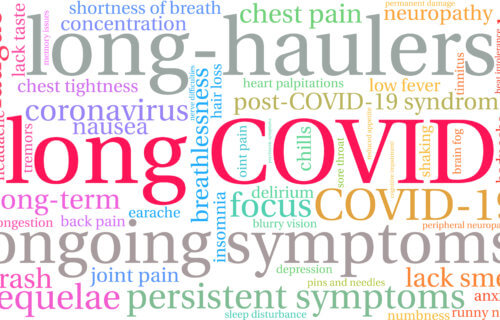SAN FRANCISCO — Long COVID — the lingering effects of a coronavirus infection — can reduce a person’s ability to exercise for months, a new study reveals.
Researchers at the University of California-San Francisco found that people suffering from long COVID may have reduced oxygen extraction in their muscles, irregular breathing patterns, and are less able to increase their heart rate during exercise. In a real-life situation, someone suffering from long COVID may have to transition from doubles tennis to playing golf and using a cart to move. Those who swim laps may have to switch to low-impact aerobics.
Other symptoms of long COVID include extreme fatigue, shortness of breath, loss of smell or taste, and muscle aches. The researchers analyzed the exercise performances of 359 participants who had recovered from the virus and compared them to 464 participants who had symptoms of long COVID.
The participants ranged in age from 39 to 56, and their average BMI fell into the overweight or obese categories. Each participant took part in specific exercise tests at least three months after they contracted the virus.
After they exercised using a treadmill or stationary bike, researchers measured their oxygen and carbon dioxide levels, and heart and lung functions. During exercise, the peak rate of oxygen for those with long COVID was 4.9 ml/kg/min lower than the group who fully recovered from COVID.
“This decline in oxygen peak rate would roughly translate to a 40-year-old woman with an expected exercise capacity of 9.5 METs, dropping to 8.1 METs, the approximate expected exercise capacity for a 50-year-old woman,” says study first author Dr. Matthew Durstenfeld from the UC San Francisco’s Department of Medicine in a media release.
Long COVID creates a ‘modest but consistent’ trend
While their results are extensive, more research is necessary to find more accurate information. The researchers state that while they found “modest but consistent” evidence suggesting exercise capacity drops off in participants with long COVID, there was “a low confidence in the magnitude of effect.” This is due to the small study sizes, and oversampling of hospitalized participants, meaning those studied often had severe symptoms when they contracted the virus.
“Further research should include long-term observational assessments to understand the trajectory of exercise capacity,” concludes senior author Priscilla Hsue, MD, of the UCSF Department of Medicine and of the Division of Cardiology at Zuckerberg San Francisco General Hospital.
“Trials of potential therapies are urgently needed, including studies of rehabilitation to address deconditioning, as well as further investigation into dysfunctional breathing, damage to the nerves that control automatic body functions and the inability to increase the heart rate adequately during exercise.”
The findings appear in JAMA Network.
South West News Service writer Alice Clifford contributed to this report.

